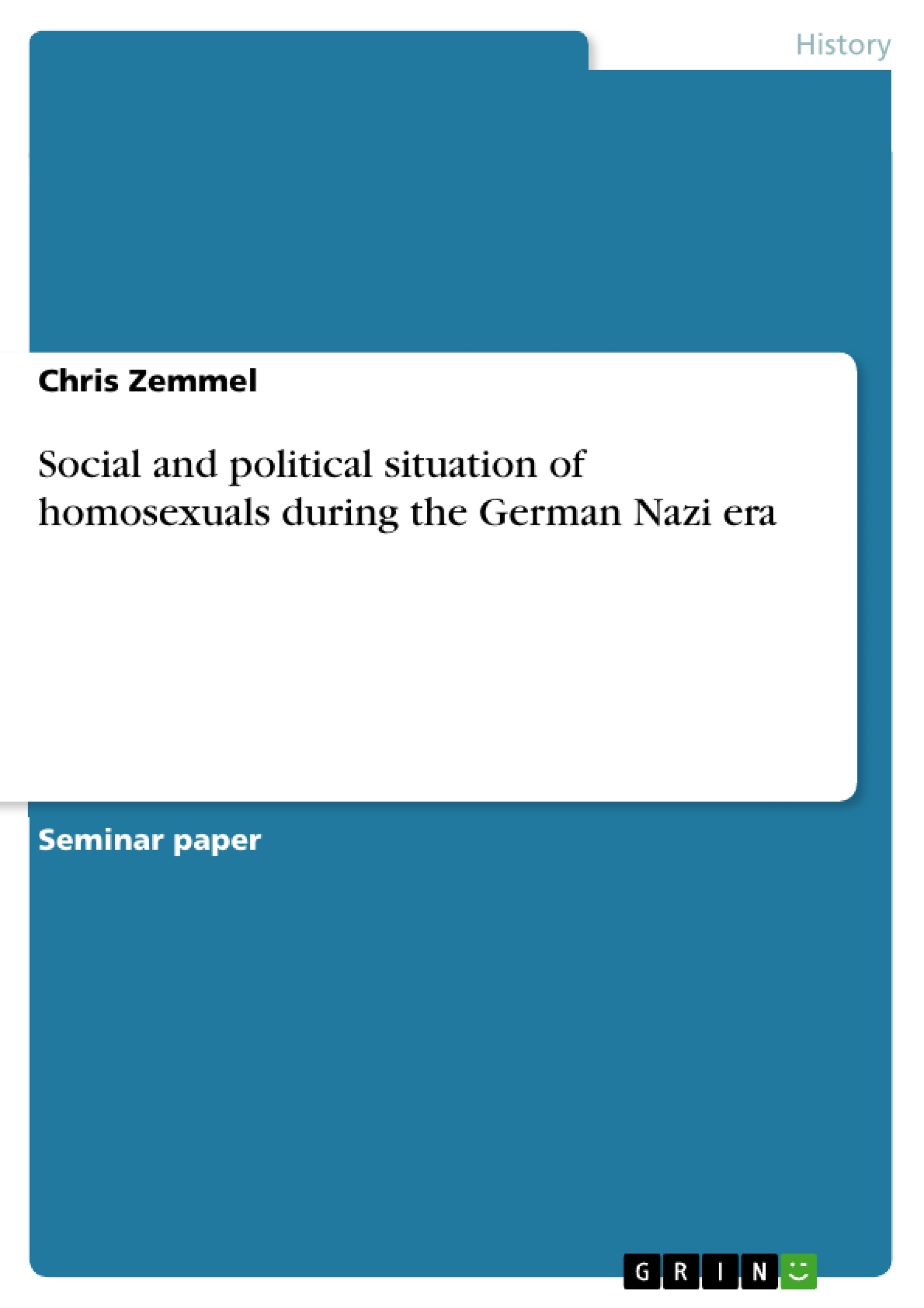In the Weimar Republic homosexuals achieved more and more acceptance. The German capital Berlin could, for example, be regarded as a liberal city and a meeting point for many lesbians and gays. Nightclubs, bars, and even travesty clubs were open and solely reserved for homosexuals. They seemed to have their own parallel society, which was somehow tolerated. Germany became more and more tolerant and legal equality of hetero- and homosexuals would have been the next logical step. However, things came different when the NSDAP party won the election in 1933. The ideological government made homosexuality a punishable offence again, leading to a bitter setback for any upcoming gay movement. After the slow improvement of social and legal conditions, which began to take scientific findings into account, all the achievements were destroyed. But why did Nazi Germany consider homosexuality a crime again and how did the lives of LGBTs change to the worse?
Inhaltsverzeichnis (Table of Contents)
- Introduction
- Main Part
- Legal Situation of homosexuals in Nazi Germany
- Paragraph 175
- Implementation and Statistics
- Social Situation of homosexuals in Nazi Germany
- Public Life
- Private Life
- Society and reasons of homosexual persecution
- Propaganda
- Education
- Military
- Religion
- Legal Situation of homosexuals in Nazi Germany
- Conclusion
Zielsetzung und Themenschwerpunkte (Objectives and Key Themes)
This text aims to explore the history of homosexual persecution in Nazi Germany, analyzing the legal situation, social conditions, and external influences that contributed to the systematic discrimination and violence against LGBTQ individuals. It examines the evolution of Paragraph 175 and its implementation, the social realities faced by homosexuals, and the role of propaganda, education, military, and religion in shaping societal attitudes.
- The legal persecution of homosexuals under Paragraph 175
- The impact of Nazi ideology on the social situation of homosexuals
- The role of external influences (propaganda, education, military, and religion) in shaping societal views on homosexuality
- The consequences of homosexual persecution, including imprisonment and concentration camps
- The historical context and development of the criminalization of homosexuality in Germany
Zusammenfassung der Kapitel (Chapter Summaries)
- Introduction: This chapter provides an overview of the historical context of homosexual persecution in Germany, tracing its roots back to the Constitutio Criminalis Carolina. It highlights the evolution of legal frameworks, from the death penalty to the introduction of Paragraph 175, and the emergence of early LGBTQ rights movements. It also introduces the main themes of the text, including the legal situation, social conditions, and societal influences that led to the persecution of homosexuals in Nazi Germany.
- Legal Situation of homosexuals in Nazi Germany: This chapter focuses on the legal framework surrounding homosexuality in Nazi Germany, specifically examining Paragraph 175. It discusses the rewriting of the law in 1935, the increased severity of punishment, and the broadening of its scope to encompass various aspects of social interaction. This section also explores the implementation of the law, highlighting the significant increase in condemnations and the establishment of the Reich Central Office for the Combating of Homosexuality and Abortion.
- Social Situation of homosexuals in Nazi Germany: This chapter examines the social conditions experienced by homosexuals in Nazi Germany, exploring both public and private life. It describes the impact of the new legal framework on the daily lives of homosexual individuals, emphasizing the fear and suppression of feelings. It may also delve into the challenges of seeking love and intimacy in a hostile environment.
- Society and reasons of homosexual persecution: This chapter investigates the external factors that contributed to the persecution of homosexuals in Nazi Germany. It explores the role of propaganda in shaping public opinion, the influence of education and military institutions, and the impact of religious attitudes on societal views. This section analyzes how these factors combined to create a climate of intolerance and justify the systematic discrimination against LGBTQ individuals.
Schlüsselwörter (Keywords)
The main keywords and focus topics of this text include Paragraph 175, Nazi ideology, homosexual persecution, LGBTQ rights, social conditions, propaganda, education, military, religion, discrimination, imprisonment, concentration camps, and historical context.
- Citar trabajo
- Chris Zemmel (Autor), 2017, Social and political situation of homosexuals during the German Nazi era, Múnich, GRIN Verlag, https://www.grin.com/document/511662



